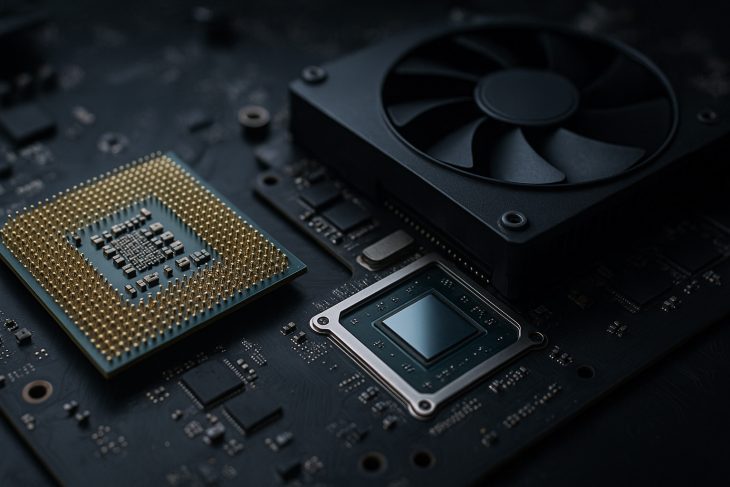
CPU and GPU bottlenecks occur when one component limits the performance of the other, causing reduced frame rates or slower processing. Understanding how and why this happens helps in optimizing hardware for gaming, rendering, and other demanding tasks. Monitoring usage, balancing components, and using a bottleneck calculator can help predict potential issues. Identifying the limiting factor ensures better upgrade decisions and smoother overall system performance.
CPU Bottleneck Basics
1. CPU Bottlenecks Occur in CPU-Intensive Games
Games relying heavily on physics calculations, AI, or simulation often stress the CPU, resulting in lower frame rates even with a powerful GPU.
2. High Frame Rate Demands Stress the CPU
At 144Hz or higher refresh rates, the CPU processes more game instructions per second, which can expose bottlenecks.
3. Single-Thread Performance Matters
Many games depend on single-core speed rather than multiple cores, making high clock speeds critical to avoid bottlenecks.
4. Background Processes Can Cause Bottlenecks
Heavy multitasking, antivirus scans, or background applications consume CPU resources, leaving fewer cycles for gaming or rendering.
5. Low-End CPUs Limit High-End GPUs
Pairing an entry-level CPU with a high-performance GPU often results in the GPU waiting for instructions, causing underutilization.
6. Overclocking Helps Reduce CPU Bottlenecks
Increasing CPU clock speed allows it to feed the GPU faster, improving performance in CPU-bound scenarios.
7. Cache Size Influences Bottlenecking
A larger CPU cache reduces data retrieval times, improving processing efficiency and reducing bottleneck potential.
GPU Bottleneck Basics
8. GPU Bottlenecks Occur in Graphically Demanding Games
High-resolution textures, ray tracing, and advanced visual effects push the GPU to its limits, causing slower frame rendering.
9. VRAM Capacity Impacts Performance
Insufficient VRAM forces the system to use slower system RAM, significantly dropping performance.
10. Resolution Plays a Major Role
Higher resolutions like 4K shift the workload to the GPU, reducing CPU bottlenecks but increasing GPU stress.
11. GPU Clock Speed Matters
A higher clock speed processes more graphical data per second, reducing the chance of frame rendering delays.
12. Anti-Aliasing and Ray Tracing Stress the GPU
Enabling these features increases computational load, creating a GPU bottleneck even with strong hardware.
13. Thermal Throttling Can Cause GPU Bottlenecks
Overheating forces the GPU to lower its clock speeds, reducing performance significantly.
14. Pairing Weak GPUs with Powerful CPUs Limits Performance
A strong CPU cannot push frame rates higher if the GPU cannot process frames fast enough.
Mixed CPU and GPU Bottleneck Factors
15. Balanced Hardware Prevents Bottlenecks
Matching CPU and GPU tiers ensures both components perform optimally without waiting for each other.
16. Driver Updates Affect Bottlenecking
Outdated drivers can cause inefficiencies in both CPU and GPU workloads, reducing performance.
17. Game Optimization Determines the Bottleneck
Some games are coded to favor CPU or GPU usage, altering which component becomes the limiting factor.
18. System RAM Speed and Capacity Matter
Slow or insufficient RAM increases latency for both CPU and GPU, creating a shared performance issue.
19. Storage Speed Affects Loading But Not Frame Rates
An SSD improves asset loading times but does not directly influence bottlenecking during gameplay.
20. Power Supply Stability Impacts Performance
Inconsistent power delivery can cause CPU and GPU throttling, indirectly creating bottlenecks.
Measuring and Identifying Bottlenecks
21. Monitoring Tools Identify Bottlenecks
Software like MSI Afterburner shows CPU and GPU usage, helping determine which component is limiting performance.
22. High CPU Usage With Low GPU Usage Indicates CPU Bottleneck
If the CPU is at 100 percent while the GPU remains underutilized, the CPU is holding back performance.
23. High GPU Usage With Low CPU Usage Indicates GPU Bottleneck
If the GPU runs near full utilization while the CPU is less active, the GPU is the limiting factor.
24. Frame Time Graphs Provide Accurate Clues
Uneven frame times often indicate CPU issues, while consistently high frame times point to GPU strain.
25. Testing Different Resolutions Helps Identify the Problem
Lowering resolution shifts the workload to the CPU, while raising it stresses the GPU.
26. A Bottleneck Calculator Offers Quick Estimates
Online tools can predict whether a specific CPU and GPU combination will cause noticeable performance limitations.
Reducing Bottlenecks
27. Upgrading the Right Component Fixes the Issue
Identifying the bottlenecked component ensures money is spent where it delivers the biggest performance gain.
28. Optimizing In-Game Settings Helps Balance Load
Lowering CPU-heavy settings like shadows or object draw distance reduces CPU strain, while adjusting textures and resolution helps with GPU limits.
29. Disabling Background Applications Frees Resources
Closing unnecessary software increases available CPU power, reducing frame rate drops.
30. Proper Cooling Maintains Stable Performance
Keeping temperatures low prevents both CPU and GPU from throttling, ensuring consistent workload distribution.
Final Thoughts
Balancing CPU and GPU performance is key to achieving smooth gaming and efficient rendering. Identifying which component limits performance helps in making informed upgrade decisions. Monitoring usage, adjusting in-game settings, and maintaining proper cooling can significantly reduce bottlenecks. Using tools like a bottleneck calculator can also provide quick insights before upgrading hardware. A well-matched system ensures both components operate efficiently, delivering consistent and stable performance across various applications.
Was this page helpful?
Our commitment to delivering trustworthy and engaging content is at the heart of what we do. Each fact on our site is contributed by real users like you, bringing a wealth of diverse insights and information. To ensure the highest standards of accuracy and reliability, our dedicated editors meticulously review each submission. This process guarantees that the facts we share are not only fascinating but also credible. Trust in our commitment to quality and authenticity as you explore and learn with us.